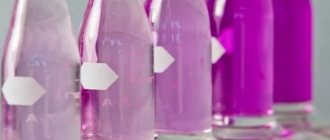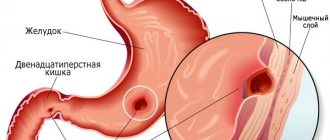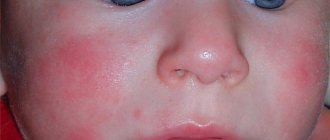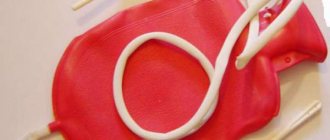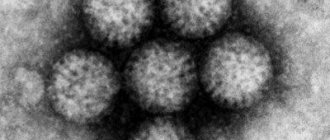Home rinsing methods
You can cleanse your stomach at home in 2 ways: tubeless, also called “restaurant”, and tube.
The probeless method is the simplest and is recommended to be performed at home . It does not require medical knowledge. This method can be used to rinse the digestive organs in adults and older children. This procedure is a self-help method for mild poisoning, that is, a person can rinse his stomach independently without assistance.
Contraindications to the probeless method are::
- Young children;
- Unconscious state of the patient;
- Cramps.
Algorithm for gastric lavage at home using the “restaurant” method:
- Prepare a large volume of liquid at room temperature. This can be boiled water, saline, soda solution, water with the addition of activated carbon or potassium permanganate. Liquid volume is about 6 – 7 liters;
- Give the victim liquid to drink . Moreover, you need to drink about 500 milliliters at a time. This will help fill the entire organ and flush all its folds;
- Induce vomiting . To do this, you need to influence the root of the tongue. You can use a spatula, spoon or fingers. Press on the root of the tongue and thereby induce gagging;
- After the person has emptied the stomach, the procedure should be repeated. It is necessary to rinse the organ until the rinsing water is clean.
To cleanse the digestive organs at home using a probe, a person requires certain medical knowledge and the availability of special equipment:
- Gastric tube;
- Funnel;
- Container for collecting rinsing water.
Algorithm for gastric lavage using the tube method:
- The patient is seated on a chair, his torso is covered with oilcloth to avoid contamination by vomit;
- A gastric tube is inserted through the mouth until the contents of this hollow organ emerge from the tube;
- A funnel must be attached to the rubber tube;
- The washing liquid is poured into the funnel in a volume of 500 milliliters, and the funnel is raised. When all the liquid has been filled in, the funnel is slowly lowered and the contents of the stomach are poured out;
- The procedure is continued until clean wash water appears.
Saline solution for poisoning
Saline solution is used for gastric lavage in case of food, alcohol and drug poisoning. It is also used for therapeutic cleansing. Salt prevents the absorption of toxins into the blood. This product removes toxic substances and bacteria from the body faster and at the same time prevents the development of severe dehydration
To prepare the saline solution you will need:
- 5 liters of warm water;
- 2 tablespoons table salt.
Another recipe for making saline solution:
- 5 liters of warm water;
- 1 teaspoon salt;
- 1 tablespoon sugar;
- 0.5 teaspoon of baking soda.
Salt must be well dissolved in water . Otherwise, irritation or even damage to the mucous membrane of the esophagus and digestive organs from salt crystals may occur.
Contraindications to the use of saline solution are:
- Peptic ulcer of the stomach and duodenum;
- Ulcers and open lesions of the esophagus.
How to rinse a child's stomach at home
The method of gastric lavage is selected depending on the age and condition of the child.
The technique for cleansing the gastrointestinal tract at home in children is the same as in adults. However, there are definitional nuances that must be taken into account.
Gastric lavage at home in children under one year of age is a serious and responsible procedure that should only be performed by a person with medical education and appropriate skills.
When cleansing, it is necessary to correctly calculate the volume of liquid, which depends on the age of the child.:
- Infants under 1 year of age will need from 500 to 700 milliliters;
- From 1 year to 1.5 years – no more than 800 milliliters;
- 2 years and older - from 1 to 2 liters.
The essence of the probing procedure
Patients who are admitted to the hospital after poisoning are often in quite serious conditions. Probing will help to quickly cleanse the gastrointestinal tract. To do this, a special long tube is used, which is inserted into the patient’s stomach through the mouth, and then liquid is poured into the organ. After doctors perform certain manipulations (details below), the water comes back out along with the contents of the stomach.
The flushing algorithm consists of certain stages, so cleansing with a probe should only be carried out by doctors.
Washing is especially effective when no more than 2 hours have passed since the poisoning and there is a possibility that the bulk of the poison is still in the stomach. A good combination is considered to be a probe rinse and subsequent administration of sorbents.
Unlike self-induction of vomiting at home, tube gastric lavage has several advantages :
- the possibility of performing the procedure on a person in an unconscious state,
- the release of toxic liquid through the probe tube eliminates burns of the esophagus and oral mucosa, which is important in case of poisoning with household chemicals or concentrated solutions,
- the unpleasant sensation is caused only by the insertion and removal of the tube, and the patient may hardly feel the rinsing itself,
- The procedure is highly effective and gives quick results.
If the toxic substance has managed to enter the systemic bloodstream, its effect can continue for a long time. This is true for long-term metabolizing (decomposing) poisons. In this case, gastric lavage must be done several times, repeated after several hours. In case of intoxication with narcotic substances, ethylene glycol, methyl alcohol and other similar slowly decomposing compounds, purification is carried out for 23 days 3-4 times a day .
The repeated entry of poisons into the stomach is explained by their release from the blood, as well as reflux from the lower parts of the gastrointestinal tract as a result of reverse peristalsis.
How to do gastric lavage in a hospital
Upon arrival of a person with poisoning in the hospital, he is required to cleanse his stomach.
Washing in a hospital is carried out using the probe method, this will require:
- Gastric tube. It is sealed on one side, there are 2 holes on the sides;
- Adapter with probe , if you need to increase the length of the gastric tube;
- Funnel;
- Ladle;
- 2 oilcloth aprons for the patient and the health worker;
- Vaseline oil;
- Pelvis;
- Sterile container for collecting rinsing water for research.
Algorithm and technique for gastric lavage in a hospital:
- Explain to the patient the process and necessity of the procedure, obtain his consent;
- Make the person sit or lie on their side;
- Measure the length to which the probe must be inserted (from the earlobe to the xiphoid process);
- Lubricate the sealed end of the probe with petroleum jelly and insert it into the oral cavity. Advance the probe carefully. If the patient has the urge to vomit, then it is necessary to allow him to breathe through his nose;
- Attach the funnel to the probe . Fill it with liquid and slowly lift it, after which the funnel also slowly lowers to the level of the organ. The rinsing water is poured into the basin. The procedure will be repeated until the wash water is clean.
To calculate the volume of fluid to be administered into an organ at one time, you need to know the patient’s weight. For 1 kilogram take 8 - 10 milliliters of liquid.
How to rinse without a probe
House washing rules
At the pre-medical stage, it is quite possible to perform gastric lavage without a medical probe. In addition, not every family can find a probe in a first aid kit. In case of mild food poisoning or while waiting for an ambulance, ordinary rinsing is quite enough to relieve intoxication and prevent dangerous consequences.
The algorithm for cleaning the stomach at home is as follows:
- The victim is seated on a chair with a hard back or laid on a sofa. The head should be tilted back so that vomit does not get stuck in the throat.
- A basin for vomit and a container with a medicinal solution are placed on the floor, and an apron is put on the patient. The person performing the manipulation puts on gloves.
- The patient is given the first dose of the solution to drink.
- The person is tilted over a basin and pressure is applied to the root of the tongue to induce vomiting. You can apply pressure with a spoon or your finger.
- The whole scheme is repeated until the soda water comes out of the patient’s stomach clean.
Contraindications
Contraindications to gastric lavage
Gastric lavage with artificial vomiting is the easiest and fastest way to cleanse the body of ingested poison. But this method has its own contraindications - if they exist, rinsing is allowed only in a hospital, under the supervision of a doctor:
- loss of consciousness or faintness;
- convulsions;
- pregnancy at any stage;
- internal bleeding from the gastrointestinal tract;
- burns of the inner surface of the larynx;
- heart diseases.
Recovery after rinsing
After cleansing the digestive organs at home, it is necessary to restore the body, and especially the gastrointestinal tract. The patient is prescribed bed rest and a set of recovery measures is carried out:
- It is recommended to apply a warm heating pad to the stomach area and feet. This will reduce stomach cramps and also eliminate trembling and chills in the patient;
- The patient should lie on his side until his nausea passes (about 40 minutes);
- When the nausea passes, you need to take an adsorbent: Enterosgel, Activated carbon, Polysorb;
- After rinsing, ensure sufficient fluid intake to correct dehydration;
- Eating should be postponed for several hours . After which you can eat often and in small portions (slimy soups, porridges, jelly);
- If there is an increase in body temperature, antipyretics and plenty of fluids are prescribed;
- To restore the microflora, the use of drugs (Linex, Bifidumbacterin, Hilak Forte) and fermented milk products (natural yogurt, fermented baked milk, kefir) are prescribed;
- Fatty, fried, spicy, smoked foods are excluded from the diet.
Victor Systemov - expert of the 1Travmpunkt site
Gastric lavage is a method of cleansing the body of toxins and poisons that have entered the stomach, and is more often used for acute poisoning. The procedure improves the patient’s condition, promotes a speedy recovery, and saves lives.
At the first symptoms of poisoning, according to treatment standards for infectious diseases, it is recommended to take the bactericidal enterosorbent PEPIDOL (2 tablespoons every 3 hours until the condition is completely normalized).
First aid for poisoning
Flushing the gastrointestinal tract is not always considered a good idea. For some types of intoxication it is completely contraindicated. That is why those around the victim must correctly assess the situation and the current condition of the patient.
First you should call an ambulance. And only after this can you begin to provide simple first aid. If the poisoned person is conscious, it is necessary to clarify with him what caused the deterioration in his health. It’s even better if you can find the product that became the source of poisoning. It could be either a spoiled dish or some kind of chemical or tablet. What is found must be preserved and then transferred, if necessary, for research. This precaution will allow doctors to provide more effective treatment.
Doctors insist that even if the victim feels relatively normal, he still needs to be shown to a doctor. It is likely that over time he will become sharply worse or will completely fall into a coma. Then it will become much more difficult to help him.
In what cases should the stomach be washed?
Indications
- Acute poisoning with food, mushrooms, medicines, alcohol.
- Narrowing of the gastric outlet
- Decreased tone of the muscle wall of the stomach or duodenum
- Intestinal obstruction
- When toxic substances are released into the lumen of the stomach. For example: urea secretion in chronic renal failure.
Contraindications
- Organic narrowing of the esophagus
- Acute bleeding from the esophagus or stomach
- Severe burns of the larynx, esophagus, stomach with acids and alkalis
- Cerebrovascular disorders
- Myocardial infarction, unstable angina, severe heart rhythm disturbances
- Unconscious state (without prior intubation). Intubation is the insertion of a special tube into the larynx and trachea to maintain patency of the airways and maintain respiratory activity.
- Absence of cough or glottal reflex
- Convulsions, convulsive state
Methods of gastric lavage
- Rinsing without using a probe
- Flushing using a thick probe
- Flushing using a thin probe
Gastric lavage without using a tube (“restaurant method”)
- If the patient cannot swallow the tube, then he can drink water on his own and then induce vomiting, thus emptying the stomach.
- You should drink in portions of up to 500 ml at a time. Then expect vomiting or stimulate it. In total, about 5-10 liters of water are required for effective gastric lavage.
Rehabilitation period
Sorbent
It is very important to know how to rinse the stomach at home according to all the rules, but rehabilitation measures for the patient after the procedure are also necessary.
At the recovery stage, drug therapy is first carried out. The patient needs to be given sorbents - regular activated carbon (one carbon tablet per kg of weight), white coal, Smecta, Enterosgel, Polyphepan, etc. Dosage - in accordance with the instructions.
After all the manipulations - complete rest and bed rest. If you have a heating pad at home, you can fill it with warm water and place it on your stomach for 5-10 minutes (no longer). Drinking plenty of fluids is also necessary. If the poisoning was minor, such treatment is usually sufficient. But when serious intoxication occurs, it is still necessary to call a doctor. In some cases, further treatment of the patient is carried out in the hospital.
Gastric lavage at home is a simple procedure, but strict adherence to the algorithm is mandatory. Inadequate treatment can cause even more harm, while quick and clear rinsing can not only protect a person from poisoning, but also save his life.
Share with your friends:
What is needed for rinsing?
- Wash solutions:
- Pure boiled water (20-24°C). Water for rinsing should not be hot, as it can dilate blood vessels and enhance the absorption of toxins, nor cold, which can cause stomach spasms.
- Saline solution (2 tablespoons per 5 liters of water). Prevents the movement of toxins and poisons further into the intestines, causing spasm of the gastric outlet sphincter.
- Light solution of potassium permanganate (potassium permanganate). Make sure that there are no small crystals of potassium permanganate left by stirring the solution well or filtering it. Since crystals can get on the mucous membrane of the esophagus and stomach and cause a burn. Potassium permanganate binds toxins and also has an antiseptic and antimicrobial effect.
- Soda solution (2 tbsp per 5 liters of water).
- Means for collecting rinsing water (basin, bucket, etc.). The rinsing water must be shown to emergency doctors, this will help in diagnosing the disease.
- Protective equipment for those helping the patient (waterproof apron, gloves). Vomit may contain viruses, bacteria, poisons and toxins that can enter the body and cause various diseases (for example: intestinal infection or viral hepatitis).
Gastric lavage using a thick tube
What is needed for rinsing?
- Gastric lavage tube; The probe itself is a tube made of a rubber mixture 80-120 cm long, a thick probe with a diameter of 10-13 mm, a thin one 5-9 mm. One end is cut off and the other is rounded and has side holes.
- Rinse solution (5-10 liters)
- Pure boiled water (20-24°C). Water for rinsing should not be hot, as it can dilate blood vessels and enhance the absorption of toxins, nor cold, which can cause stomach spasms.
- Saline solution (2 tablespoons per 5 liters of water). Prevents the movement of toxins and poisons further into the intestines, causing spasm of the gastric outlet sphincter.
- Light solution of potassium permanganate (potassium permanganate). Make sure that there are no small crystals of potassium permanganate left by stirring the solution well or filtering it. Since crystals can get on the mucous membrane of the esophagus and stomach and cause a burn. Potassium permanganate binds toxins and also has an antiseptic and antimicrobial effect.
- Soda solution (2 tbsp per 5 liters of water).
- Important! Correctly calculate a single dose of infusion (5-7 ml per 1 kg of patient’s body weight). The simultaneous introduction of a large volume of liquid into the stomach promotes its entry into the intestines.
- Funnel with a capacity of 500ml-1 l, mug
- Towel, napkins
- Container for rinsing water
- Gloves, waterproof apron
- Vaseline oil or glycerin
How to do it?
- Make sure the tube goes into the stomach
Options:
- The beginning of the release of gastric contents when the tube is lowered below the level of the stomach
- Using a Janet syringe, inject 20 ml of air into the stomach, while listening with a phonendoscope or directly leaning your ear against the abdominal wall in the stomach area for characteristic sounds.
- Draw the contents from the stomach into a syringe
- Attach the funnel to the probe , then, holding the funnel at the level of the stomach, pour 500-1000 ml of water into it.
- Then slowly lift the funnel to the level of the face or above the level of the stomach (if the patient is lying down). As soon as the water reaches the level of the mouth of the funnel, lower the funnel below the level of the stomach, then the contents of the stomach will begin to pour into the prepared container for collecting rinsing water. The first portion of rinsing water is sent for laboratory testing.
- When you pour water into the funnel, make sure that it is not completely empty, otherwise air will enter the stomach, which will complicate rinsing.
- Repeat the procedure until the rinsing water is clean (use prepared 5-10 liters of water).
- After completing the procedure, disconnect the funnel and slowly remove the probe , wrapping it in a napkin or towel.
Note:
- Correctly calculate the portion of a single injection of liquid (5-7 ml per 1 kg of patient body weight). Too much water introduced at a time helps to open the outlet of the stomach and allow toxins and poisons to enter the intestines.
- Monitor the amount of fluid introduced and removed (the difference should not exceed 1% of the patient’s weight). Absorption of large amounts of liquid into the body can lead to serious consequences (“water poisoning”).
Video:
Gastric lavage using a thin gastric tube
What is needed for rinsing?
- Thin gastric tube (diameter 5-9 mm)
- Vaseline oil or glycerin
- Rinse solution (5-10 liters)
- Pure boiled water (20-24°C).
- Saline solution (2 tablespoons per 5 liters of water).
- Light solution of potassium permanganate (potassium permanganate)
- Soda solution (2 tbsp per 5 liters of water).
- Glass with water (50ml) and drinking straw
- Syringe Janet
- Band-Aid
- Towel, napkins
- Gloves
- Container for washing water (basin, bucket, etc.)
- 5-10 liters of rinsing solution
